Related Research Articles
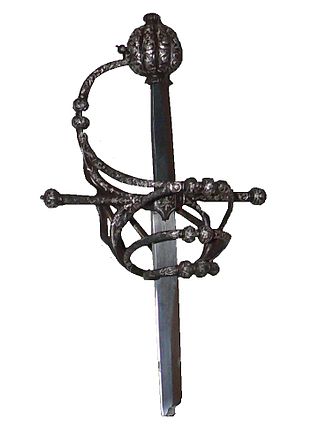
The hilt is the handle of a knife, dagger, sword, or bayonet, consisting of a guard, grip and pommel. The guard may contain a crossguard or quillons. A tassel or sword knot may be attached to the guard or pommel.
The spatha was a type of straight and long sword, measuring between 0.5 and 1 m, with a handle length of between 18 and 20 cm, in use in the territory of the Roman Empire during the 1st to 6th centuries AD. Later swords, from the 7th to 10th centuries, like the Viking swords, are recognizable derivatives and sometimes subsumed under the term spatha.
The institution known as leiðangr, leidang (Norwegian), leding (Danish), ledung (Swedish), expeditio (Latin) or sometimes lething (English), was a form of conscription to organize coastal fleets for seasonal excursions and in defense of the realm typical for medieval Scandinavians and, later, a public levy of free farmers. In Anglo-Saxon England, a different system was used to achieve similar ends, and was known as the fyrd.

The kampilan is a type of single-edged sword, traditionally used by various ethnic groups in the Philippine archipelago. It has a distinct profile, with the tapered blade being much broader and thinner at the point than at its base, sometimes with a protruding spikelet along the flat side of the tip. The design of the pommel varies between ethnic groups, but it usually depicts either a buaya (crocodile), a bakunawa, a kalaw (hornbill), or a kakatua (cockatoo)..
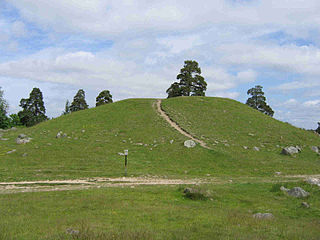
Björn at Haugi, Björn på Håga, Björn II or Bern was, according to Hervarar saga, a Swedish king and the son of Erik Björnsson, and Björn ruled together in diarchy with his brother Anund Uppsale. Björn at Haugi is sometimes identified with the historically attested Björn, a local Swedish ruler mentioned in the 9th-century Vita Ansgarii by Rimbert.

A shield-maiden was a female warrior from Scandinavian folklore and mythology.

Knowledge about military technology of the Viking Age is based on relatively sparse archaeological finds, pictorial representations, and to some extent on the accounts in the Norse sagas and laws recorded in the 12th–14th century.
Snorri Thorfinnsson most likely born between 1004 and 1013, and died c. 1090) was the son of explorers Þorfinnur Karlsefni and Guðríður Þorbjarnardóttir. He is considered to be the first child of European descent to be born in the Americas, apart from Greenland. He became an important figure in the Christianisation of Iceland.

Thorfinn Karlsefni Thórdarson was an Icelandic explorer. Around the year 1010, he followed Leif Eriksson's route to Vinland in a short-lived attempt to establish a permanent settlement there with his wife Gudrid Thorbjarnardóttir and their followers.
Aud the Deep-Minded, also known as Unn, Aud Ketilsdatter or Unnur Ketilsdottir, was a 9th-century settler during the age of Settlement of Iceland. The main source of information about her life in Iceland is Sturla Þórðarson's Landnámabók; Laxdæla saga, which calls her Unn, gives a varying account but has more on her background, and she also figures in several other sagas, including Njáls saga, Eyrbyggja saga, Eiríks saga rauða and Grettis saga.
Ketill Björnsson, nicknamed Flatnose, was a Norse King of the Isles of the 9th century.

The Viking Age sword or Carolingian sword is the type of sword prevalent in Western and Northern Europe during the Early Middle Ages.
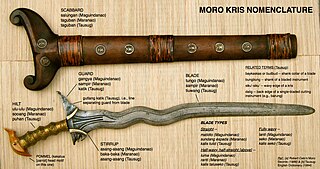
A kalis is a type of Philippine sword. The kalis has a double-edged blade, which is commonly straight from the tip but wavy near the handle. Kalis exists in several variants, either with a fully straight or fully wavy blade. It is similar to the Javanese keris, but differs in that the kalis is a sword, not a dagger. It is much larger than the keris and has a straight or slightly curved hilt, making it a primarily heavy slashing weapon.
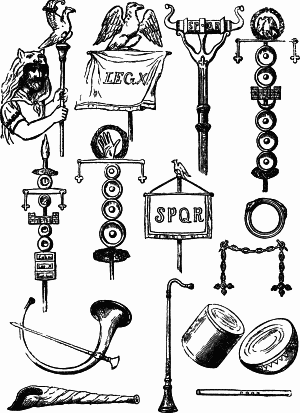
Roman military personal equipment was produced in large numbers to established patterns, and used in an established manner. These standard patterns and uses were called the res militaris or disciplina. Its regular practice during the Roman Republic and Roman Empire led to military excellence and victory. The equipment gave the Romans a very distinct advantage over their barbarian enemies, especially so in the case of armour. This does not mean that every Roman soldier had better equipment than the richer men among his opponents. Roman equipment was not of a better quality than that used by the majority of Rome's adversaries. Other historians and writers have stated that the Roman army's need for large quantities of "mass produced" equipment after the so-called "Marian Reforms" and subsequent civil wars led to a decline in the quality of Roman equipment compared to the earlier Republican era:
The production of these kinds of helmets of Italic tradition decreased in quality because of the demands of equipping huge armies, especially during civil wars...The bad quality of these helmets is recorded by the sources describing how sometimes they were covered by wicker protections, like those of Pompeius' soldiers during the siege of Dyrrachium in 48 BC, which were seriously damaged by the missiles of Caesar's slingers and archers.
It would appear that armour quality suffered at times when mass production methods were being used to meet the increased demand which was very high the reduced size cuirasses would also have been quicker and cheaper to produce, which may have been a deciding factor at times of financial crisis, or where large bodies of men were required to be mobilized at short notice, possibly reflected in the poor-quality, mass produced iron helmets of Imperial Italic type C, as found, for example, in the River Po at Cremona, associated with the Civil Wars of AD 69 AD; Russell Robinson, 1975, 67
Up until then, the quality of helmets had been fairly consistent and the bowls well decorated and finished. However, after the Marian Reforms, with their resultant influx of the poorest citizens into the army, there must inevitably have been a massive demand for cheaper equipment, a situation which can only have been exacerbated by the Civil Wars...
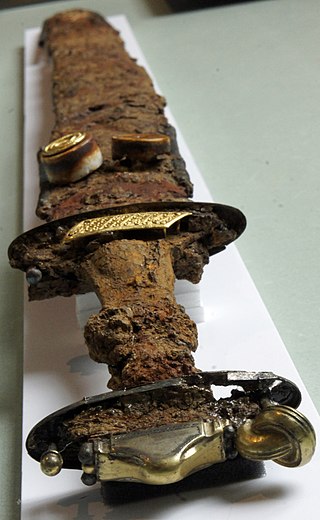
The Migration Period sword was a type of sword popular during the Migration Period and the Merovingian period of European history, particularly among the Germanic peoples. It later gave rise to the Carolingian or Viking sword type of the 8th to 11th centuries AD.
The Medieval period in England is usually classified as the time between the fall of the Roman Empire to the beginning of the Renaissance, roughly the years AD 410–1485. For various peoples living in England, the Anglo-Saxons, Anglo-Danes, Normans and Britons, clothing in the medieval era differed widely for men and women as well as for different classes in the social hierarchy. The general styles of Early medieval European dress were shared in England. In the later part of the period, men's clothing changed much more rapidly than women's styles. Clothes were very expensive and both the men and women of lower social classes continued also divided social classes by regulating the colors and styles these various ranks were permitted to wear. In the early Middle Ages, clothing was typically simple and, particularly in the case of lower-class peoples, served only basic utilitarian functions such as modesty and protection from the elements. As time went on the advent of more advanced textile techniques and increased international relations, clothing gradually got more and more intricate and elegant, even with those under the wealthy classes, up into the renaissance.
Bjǫrn Ketilsson, nicknamed the Easterner, was a Norwegian Viking of the 9th century.
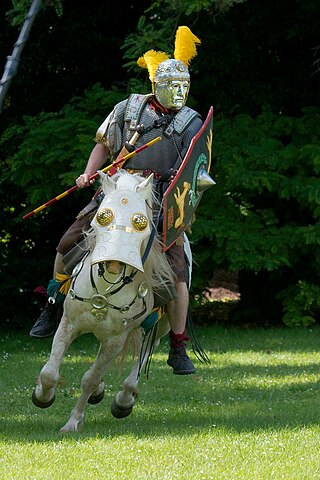
The hippika gymnasia were ritual tournaments performed by the cavalry of the Roman Empire to both practice their skills and display their expertise. They took place on a parade ground situated outside a fort and involved the cavalry practicing manoeuvring and the handling of weapons such as javelins and spears. The riders and their mounts wore highly elaborate armour and helmets specially made for display purposes, decorated with images from classical mythology. Such tournaments served several purposes, improving the riders' skills, helping to build unit morale and impressing dignitaries and conquered peoples.
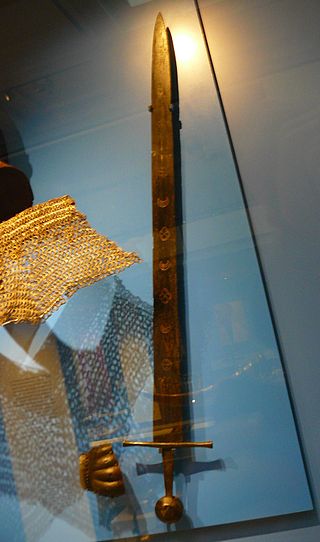
In the European High Middle Ages, the typical sword was a straight, double-edged weapon with a single-handed, cruciform hilt and a blade length of about 70 to 80 centimetres. This type is frequently depicted in period artwork, and numerous examples have been preserved archaeologically.

Alternatively known as Eurasian Sabres, or Nomadic Sabres, these swords were used by a variety of nomadic peoples of the Eurasian steppes, including Turkic and Mongolic groups and were in primary use between the 8th and 14th centuries. One of the earliest recorded sabres of this type was recovered from an Avar grave in Romania dating to the mid-7th century.
References
- ↑ Harrison, Mark (1993). Viking Hersir (PDF). Oxford: Osprey Publishing.
- ↑ Petersen's Typology
- ↑ Miller, Christopher L. "The Sword Typology of Alfred Geibig". myArmoury.com. Retrieved 2013-05-29.
- ↑ "Hersir, Viking" . Retrieved 2013-05-29.
- ↑ "Dugdale-Pointon, TDP. (21 March 2001), Hersir, Viking".
- ↑ Harrison, Mark (1993). Viking Hersir. Oxford: Osprey Publishing.
- ↑ Harrison, Mark (1993). Viking Hersir. Oxford: Osprey Publishing. p. http://brego-weard.com/lib2/003_Viking_Hersir_AD_793-1066(OCR)%5B1855323184%5D.pdf.
- ↑ Ketil Flatnev (Store norske leksikon)
- ↑ "Landnámabók, Sturlubók, 11. kafli
- ↑ Scudder, Bernard (2001). The Sagas of Icelanders. Penguin. p. 52.
- ↑ "Landnámabók, Sturlubók, 10. kafli"